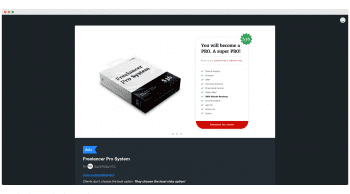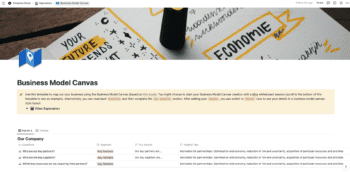Use this template to create your company SOPs (Standard Operating Procedures) in Notion.
Buy on
Contents
- Notion – Standard Operating Procedures (SOPs) Template
- What is an SOP Manual?
- 5 Steps to Creating Powerful Standard Operating Procedures
- STEP 1 – Develop a list of processes that need SOPs
- STEP 2 – Plan how to develop and manage SOPs
- STEP 3 – Collect Information for the Content of Your SOP
- STEP 4 – Write, review, edit and publish your SOPs
- STEP 5 – Maintaining your SOP over time
Notion – Standard Operating Procedures (SOPs) Template
Use this template to create your company SOPs (Standard Operating Procedures) in Notion. A standard operating procedure is a step-by-step set of instructions that helps employees perform their tasks in an efficient manner. To put it plainly, a SOP documents the steps involved in performing a particular task and is a common example of process documentation. It’s especially important to have a written procedure for a complex task that needs to comply with regulations.
——————————————
What you need before purchase
- Basic knowledge of how to use Notion
- Paid Notion account if you want to add lots of content to your template / Notion account (sign up here). Not much content? You’re able to use their free account.
After purchase, you’ll be able to view the template immediately. The template can be added to your Notion account by:
- Click on the template download link in Gumroad
- When viewing the Notion template, click on the “Duplicate” link in the top-right of your screen
- The template will now be available in your own Notion account
What is an SOP Manual?
An SOP manual is a document that contains all the standard operating procedures (SOP) for your business. It should be concise and easy to understand, but also contain enough information so that you can follow it without having to refer back to other documents. The most common way of creating one is by using Microsoft Word, Google Docs or Notion.
5 Steps to Creating Powerful Standard Operating Procedures
- STEP 1 – Develop a list of processes that need SOPs
- STEP 2 – Plan the process for developing and managing SOPs
- STEP 3 – Collect information for the content of your SOP
- STEP 4 – Write, review and publish your SOP
- STEP 5 – Maintaining your SOP over time
STEP 1 – Develop a list of processes that need SOPs
The first step in creating an effective standard operating procedure is to identify all the processes that will be affected by it. This can be done by asking yourself questions like these:
- What are the steps involved in performing each task?
- How often do I perform this task?
- Is there any documentation required?
- Does anyone else have access to this information?
- Who has responsibility for maintaining this information?
- Are there any special considerations or requirements for this task?
Once you’ve identified what needs to be documented, you should also consider who will be responsible for writing, reviewing, publishing and maintaining the document. It may be appropriate to assign different people with specific responsibilities depending on their level of experience and expertise. For example, if you have a new employee joining your team, you might want to give them some training before assigning them the responsibility of writing and updating the SOP.
STEP 2 – Plan how to develop and manage SOPs
Once you know which processes require standard operating procedures (SOPs), you must decide how best to write and maintain those documents. The following tips can help you plan your approach:
- Create a template for your SOPs. You can use Microsoft Word as a starting point, but make sure you customize it to meet your organization’s unique needs.
- Use templates to reduce the amount of time needed to create and update SOPs.
- Include a section at the beginning of each SOP that includes important contact information such as name, email address, phone number and website URL.
- Make sure that the document is easy to read and understand.
- Keep the document simple so that everyone on your team understands its purpose and uses it correctly.
- If possible, include screenshots or diagrams to illustrate key points.
- Consider using a digital format such as PDF or HTML or the above Notion template instead of paper copies.
- Use plain text formatting rather than fancy fonts.
- Avoid including unnecessary details.
- Provide links to other relevant documents where applicable.
- Update the document whenever changes occur.
- Review the document periodically to ensure that it accurately reflects current practices.
STEP 3 – Collect Information for the Content of Your SOP
Before you start writing, you’ll need to collect information about the processes that will be covered by your SOP. Here are some examples of things you might want to include:
- A description of the process
- An explanation of why the process exists
- Steps involved in performing the process
- Any special considerations or requirements
- References to related policies, standards or guidelines
- Links to external resources
STEP 4 – Write, review, edit and publish your SOPs
Once you’ve collected the necessary information, it’s time to write your SOPs. Start by creating a draft version of the document. This allows you to get feedback from others and incorporate their suggestions into the final product. After you’re satisfied with the content, you can share it with others within your organization. You can also post it online for public viewing. Finally, once you’ve reviewed all comments and incorporated any suggested revisions, you can publish the document.
STEP 5 – Maintaining your SOP over time
It’s important to keep your SOP up-to-date and accurate. To do this, you’ll need to regularly review the document and make updates when necessary.
You can accomplish this task in one of two ways:
- Automate the process. In this case, you can set up an automated workflow that automatically sends out emails to notify you when there are updates to the document.
- Manually check the document every few months.
If you choose option #1, you may find it helpful to automate the process by setting up a recurring calendar event to send yourself an email reminder. For example, if you have a monthly meeting scheduled, you could schedule the reminder to go off 30 days before the date of the meeting.

















